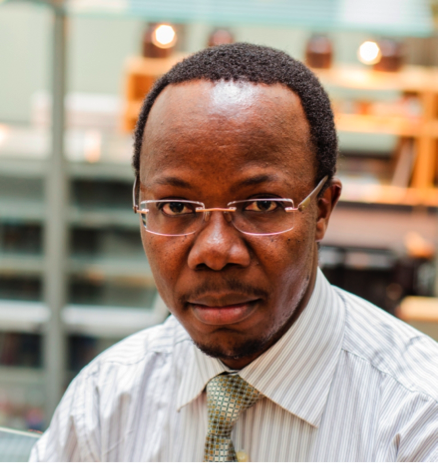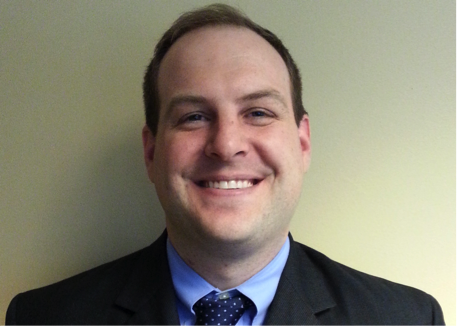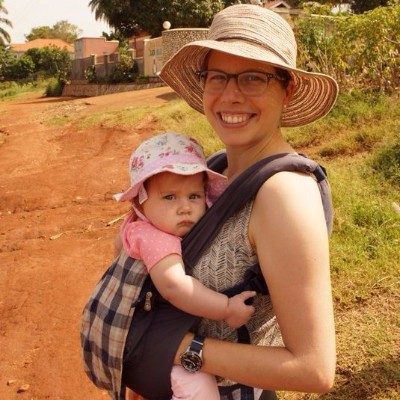 Henry Ddungu recently published an article in the Journal of the American Medical Association based on findings from the “TOTAL Randomized Clinical trial, which monitored the “Effect of Transfusion of Red Blood Cells with Longer vs. Shorter Storage Duration on Elevated Blood Lactate Levels in Children with Severe Anemia” in Uganda.
Henry Ddungu recently published an article in the Journal of the American Medical Association based on findings from the “TOTAL Randomized Clinical trial, which monitored the “Effect of Transfusion of Red Blood Cells with Longer vs. Shorter Storage Duration on Elevated Blood Lactate Levels in Children with Severe Anemia” in Uganda.
Category: Uganda Page 1 of 2

Alumnus Nathan Bahr recently published two articles in collaboration with his colleagues at Makerere University in Kampala, Uganda and the University of Minnesota. The first article is about the “Seroprevalence of histoplasmosis in Kampala, Uganda, published in Medical Mycology. The second article is on the “The Effect of Structural Violence on Patients with Sickle Cell Disease, published in the Journal of Health Care for the Poor and Underserved.

Debra Olson, DNP, MPH, RN, COHN-S FAAOHN is Executive Director of the Center for Global Health and Social Responsibility at the University of Minnesota and Co-PI of the NPGH Research Fellows Training Consortium. Her research interests include the scholarship of teaching and learning, occupational and environmental health, and public health emergency preparedness and response.
What drew you to global health?
At age five I had a mentor who was a public health nurse, and she sort of adopted me as a member of her faith community and ingrained in me the need to work in public health and serve communities world-wide. She was an energizing individual with a truly global perspective. Mentorship can happen at all ages.
What have you been working on recently?
I just returned from Uganda where I was with the University of Minnesota (UMN) celebrating over 10 years of collaboration with Makerere University’s Infectious Disease Institute with the launching of the Uganda Hub of Innovation as part of our academic health center. We are expanding and deepening reciprocal partnerships to support transdisciplinary, lasting infrastructures to advance global health research and education. The Hub is starting up with an operations manager on the ground and two spaces for students and faculty to work. The focus will be on global health across disciplines and across borders, and builds on the strong collaborations we have there while energizing new scientists and new research in a way that is truly partnered with our Uganda colleagues. The development of this inaugural hub as a geographic focus for research and education supported by our academic health center is an exciting step in our global activities.
Tell us about your emergency response simulations:
I have worked on everything from phone apps (psychological first-aid), to online games for everyone from high school students to graduate students. I use simulations to help learners apply knowledge. I have found it interesting to research how technology-driven simulations as well as simulations on the ground can help people really ingrain the concepts that they need for emergency preparedness and response. Emergencies come up daily in global health, and practicing response together in a non-threatening environment before a disaster happens can be really valuable. When the I-35W Bridge collapsed in Minnesota, almost 10 years ago, those who responded to that emergency noted that it was one of the most organized responses to a disaster. Unfortunately several people were lost, but it could have been more if responders had not trained and practiced together, and responded in an amazingly coordinated way.
Why did you want to get involved with the NPGH Fellows program?
Fellowships are so important because it gives learners a time-out to concentrate and develop skills in country. Being a learner is not based on age or profession, but based on a desire to learn for greater impact. Fogarty Fellows are all over the world taking time to concentrate on learning in a context that they may not be familiar with. Learning in-country is vital in order to do global research in a collaborative way.
What are some of the advantages with bringing technology to the classroom? Disadvantages?
Access is the greatest advantage to technology enhanced learning. Many colleagues around the world are not able to journey to places where they can access the information they need. Technology is a way to help people have better access to information. At the same time it’s one of the challenges; we can be overwhelmed with too much information and not enough knowledge. Learning opportunities need to be designed and delivered in a way that reflects strong principles of teaching and learning. In the first years of e-learning often there were PowerPoints stuck up on the web. That’s not good pedagogy. When we started e-learning at the University of Minnesota, I wrote grants to support our efforts. That gave us the opportunity to bring together a team of designers and content experts that worked together in using technology as a complement to other applied experiences. Relationships, another important part of learning, still need to be built into engagement of the learner, teacher and practice partners. Once a relationship is in place knowledge can be applied in partnership. The Fogarty Fellows program builds relationships for strong partnerships.

Daniel Low is a medical student at the University of Washington, and a current Fogarty Scholar working at the Uganda Cancer Institute on access to care and complications of HIV and cancer co-morbidity. He has worked on projects in Malawi, Honduras, Tanzania, and Kenya.
With my current project stuck in administrative delays, I have developed two other side projects focused on enhancing palliative and hospice care at the Uganda Cancer Institute. The more I have borne witness to in-hospital deaths, the more I have wondered if these were “good” deaths, and if not, what would a “good” death look like in a Ugandan context?
Interestingly, Uganda has one of the most advanced palliative and hospice care programs in all of sub-Saharan Africa. Over 90 districts in the country have hospice offices offering in-home services, including oral morphine, something often severely lacking in end-of-life care in other parts of Africa. Furthermore, palliative care organizations have trained thousands of local healthcare providers, while palliative care practices are now taught in all medical schools in Uganda.
Nonetheless, there are usually at least 4-5 in-hospital deaths each week at the Uganda Cancer Institute (UCI). So the question remains, are these “good” deaths? Recent research in urban Uganda suggests probably not. Most people here, like in the States, would prefer to die at home. Pain management remains a problem, as do many other quality of life measures at the end of life.
Most of our patients present with late stage cancers, where a fix is often untenable; death is inevitable. In such a scenario, we are left in uncharted waters. We have been trained to prevent death, not to engage with it. It is a tricky crossroads, a place that many doctors, both here and in the States, don’t know how to comfortably navigate. It is also a place where spirituality tends to play a larger and larger role.
For some, this means thinking of the world to come, about reuniting with family in days of old. It’s about being closer to God. In the meantime, it may mean making amends and repenting. For others, this is just one step in a long line of reincarnation. This is only part of the cycle. Still others fear retribution, while some don’t think of anything beyond what is right in front of them, trying to instead focus on the moments that remain.
Regardless of the spiritual convocation, the end of life is a time of great meaning, fear and hope for many. In these moments I am reminded of Rabbi Abraham Joshua Heschel’s words, “just to be is a blessing. Just to live is holy.” Sometimes it takes confronting death to learn how much of a blessing it is to simply live. We learn to appreciate just how holy life is.
I think that’s how Shayna felt at the end of her all too brief life. When she sensed that the end was coming, she asked for all of the healthcare providers who had taken care of her to come near. She expressed her gratitude for everything that had been done for her. She talked about medications, friendly smiles from nurses, procedures to remove fluid from her pleural space so she could breathe better, words of encouragement from doctors, and general support. Then, as her breathing became labored and she knew this was it, she asked her family to sing her favorite hymn to her. Lost amidst the melodic song of her family, she peacefully died.
Shayna’s death was tough for me, as she was one of the few pediatric patients who spoke impeccable English and therefore was someone whom I had the pleasure of getting to know. She also happened to be the first pediatric patient I saw this trip. But hers was a “good” death.
I wonder how her end-of-life experience can become more regular. At only 14-years-old, how had she learned the blessing of just being? She was calm and at peace with the world, yet vibrant and alive all the while. She asked questions about her leukemia, and though sometimes fearful of the answers, she had genuine curiosity. She lived in amazement of life. To me, she lived what seemed to be a holy life. She modeled the approach that Heschel advocates for all of us: “Our goal should be to live life in radical amazement. To get up in the morning and look at the world in a way that takes nothing for granted. Everything is phenomenal; everything is incredible; never treat life casually. To be spiritual is to be amazed.”
Life is amazing. I see that awe when I walk to work, in the beauty of the acacia trees that line the road on the way to the hospital. I am amazed by the organized chaos of people walking to work, perhaps in a hurry but nonetheless always in a time and space to greet one another and offer a comforting smile. I feel that awe strolling the wards, seeing the human innovation of infusion treatments and radiotherapy. But most of all, I see that amazement in my patients, my colleagues and my friends. I feel that awe when Dr. Racheal stays at clinic until 8pm to take care of her patients, even though she is tired, hasn’t had a chance to eat lunch and has her own life to return to in the evening. I feel that holiness when I play peek-a-boo with Josiah, as he gaily waits in his undersized hospital bed for another round of chemotherapy.
That holiness is all around us; it merely is how we choose to view the world.

Jennifer Ross, MD, MPH, is a current NPGH Fogarty Fellow living in Uganda. Her research project is on the use of co-trimoxazole prophylaxis for malaria in HIV patients in Uganda and Kenya. She earned her advanced degrees at the Oregon Health and Science University, and has worked for the CDC.
My daughters will be too young to remember our Fogarty year in Uganda – they will be 18 months and three years when we move back to Seattle – but being here as a family completely shapes our experience. Since half of the Ugandan population is under the age of 15, there are children everywhere. We attract a lot of attention on the street as a ‘muzungu’ family, and our kids create a natural connection with nearly everyone we meet. The friendliness of strangers toward our children makes us feel welcome, even if it’s not exactly how the interaction would work at home. Asking after the children is often part of a greeting in Uganda, and people refer to others by the name of their eldest child, so I am “Mama Sonia” to our nanny and our neighbors.
In many ways, this feels like the ideal setting to be pursuing research while also raising young children. High-quality child care is affordable for us and abundant here, and we live close enough to my workplace for me to walk home at lunchtime to nurse my baby. Our life here seems to allow for more breathing room; every once in a while on a Sunday afternoon, after we have played outside and before the time difference allows us to FaceTime with the grandparents, we actually feel a little bored. We haven’t felt bored in years! The other key to our life here is my spouse’s efforts. We consider this a paternity year for him, adopting the example of other countries that support fathers as well as mothers to take time with their little ones. He left a good job in Seattle to take on the task of coordinating our home life here, where, in addition to the children, there’s often something that needs repairing, or a utility bill that must be paid in person. All of these factors grant me precious blocks of uninterrupted time to write and think about my projects.
It is not perfect – I still pull out my laptop to work many evenings after the girls are asleep, I don’t travel to as many field sites as I’d like, and my worrying about how we would manage a car accident or serious illness still keeps me awake some nights – but for now, our arrangement here is working well. Since coordinating a clinical or research career with a busy family life doesn’t seem particularly easy anywhere, I consider this a success. And even if my daughters don’t distinctly remember our time here, living here will certainly impact them. Just this week my daughter came home from pre-school singing Christmas carols with a Ugandan accent.

